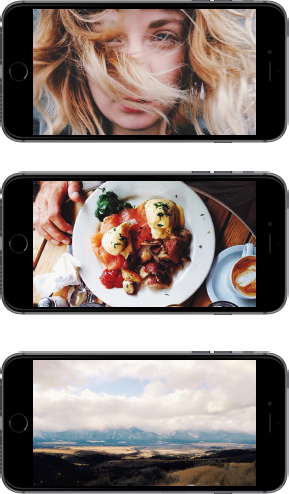As the iPhone reaches its 10th birthday, Robyn Lange, a curator at Shutterstock, looks back at how the smartphone has influenced photography, and in turn visual marketing.
From stunning landscape holiday snaps, to augmented reality bunny selfies, there is no question that the iPhone has introduced a number of visual trends that have revolutionised consumers’ connection with media. And as brands bid to make more intimate and engaging connections with their customers, these visual trends have trickled down into their marketing campaigns.
Amateur photography
The iPhone placed a high-resolution camera in everyone’s pockets, and suddenly everyone became a photographer. Amateur photography has now become the norm, and brands are making use of this style of photography.
Gritty and urban street photography with images that appear to be taken amongst friends in relaxed environments, create raw, laid-back and casual effects in ads for brands that target the younger demographics such as Coca Cola and Adidas. Apple themselves have also used images taken by amateur photographers to promote their own iPhone, with ads featuring street style photos appearing in outdoor advertisements for the smartphone with the slogan ‘Shot on iPhone’.

In Shutterstock’s image library, the number of photos taken on iPhones has risen dramatically in recent years. Currently, there are 812k iPhone uploads on Shutterstock. 78% of these photos were uploaded in 2016, 17% uploaded in 2015 and 5% were uploaded before 2015. And as iPhone camera technology continues to improve, we expect this figure to rise – in 2017, iPhone image numbers on Shutterstock are predicted to hit 1.5million.
Selfies
A new form of self-expression thanks to a front-facing camera, and made famous by celebrities such as Kim Kardashian and Kendall Jenner, is the globally renowned selfie. Leading companies such as Dove and JetStar have used selfie images to front ad campaigns for their beauty and travel products.
By using images of selfies, they have added an authentic and personal element to what could otherwise be conceived as corporate brand narratives in their ad campaigns.
Real-time
The iPhone has added a new element of real-time marketing, by making it easier than ever to capture live-events as they unfold. iPhone apps such as Instagram Stories, Snapchat and Facebook Live, have allowed brand marketers for companies to broadcast events at no cost. Burberry, the British fashion brand has used this widely available technology to live-stream events like fashion shows, bringing brand and consumer closer together. Brand opportunities for real-time marketing are limitless, and marketers are now under pressure to explore real-time marketing and maximise its potential to engage audiences.
Vertical photos and videos
From ads to social media posts, the iPhone has literally changed the direction in which marketers must now present visual content. Vertical viewing is now the mainstream on mobile, and brands that have planned ads specifically for vertical formats have typically fared better than campaigns with roots on TV that are quickly repurposed for the iPhone.
UFC’s vertical video ads for example showed an 89% average video completion rate and 10% average engagement rate with users, meaning one in ten viewers who watched the advert took action. This ad campaign exceeded marketers’ expectations in contrast to UFC’s horizontal ads, and we will no doubt see more brands targeting millennials in this format in the future.
Looking ahead at the iPhone 8
Apple is due to launch the iPhone 8 later this year. Shrouded in mystery, it’s expected to further revolutionize technology, design and photography. Rumoured features include augmented reality, a 3D front-facing camera for higher quality selfies, facial and iris recognition technology, and enhanced low-light capabilities.
These image technology features will continue to take the lead on developing image trends that we see not just on friend’s social media pages, but in marketing campaigns as well. As we pass this 10-year milestone, the power of the iPhone on photography, and visual culture, cannot be underestimated.

